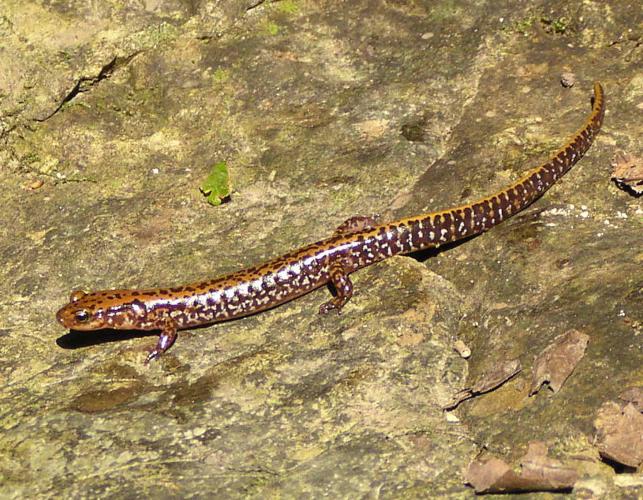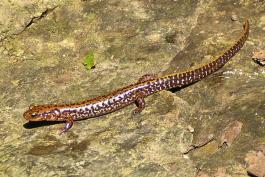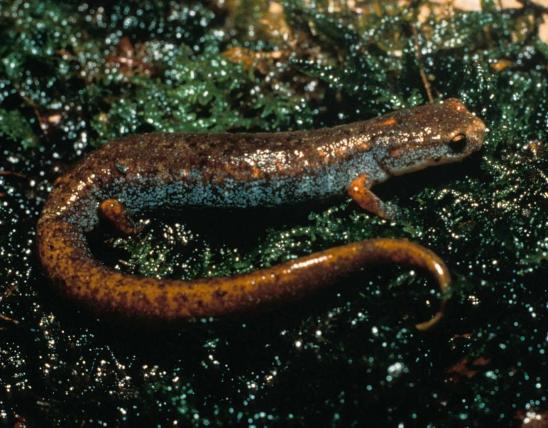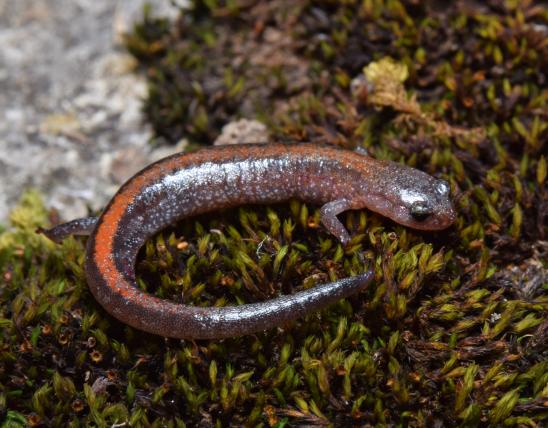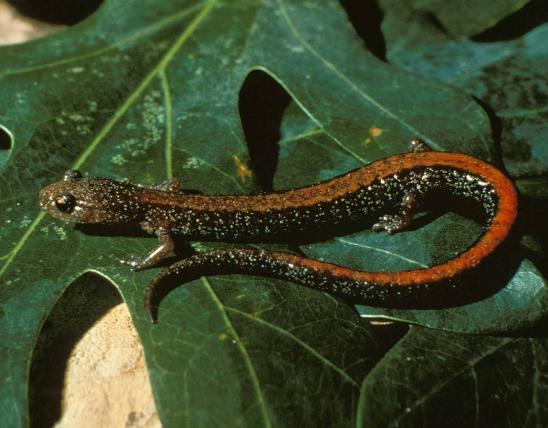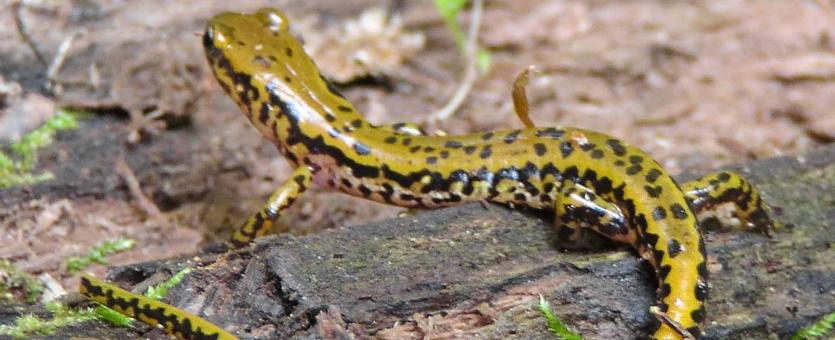
Missouri has two subspecies of the long-tailed salamander (Eurycea longicauda). The two look slightly different, and they occur in different regions of the state. There is a zone where their ranges overlap, and intermediate forms occur in that zone.
- The eastern long-tailed salamander (E. longicauda longicauda) is a medium-sized, slender salamander with a long tail. It is usually yellow but may vary from greenish yellow to orange yellow. The belly is plain yellow. There are dark brown or black markings and spots along the back and sides. The tail has prominent dark vertical bars. There are 13 or 14 costal grooves (vertical grooves on the sides of the body). It occurs in southeastern Missouri, though not in the Bootheel lowlands.
- The dark-sided salamander (E. longicauda melanopleura) has large amounts of dark pigment along the sides, from the head onto the tail, and has larger and more numerous dark spots on the back. The sides are often flecked with white. The vertical bars on the tail are more irregularly shaped and may form dark, wavy lines. The ground color varies from yellowish green to yellowish brown. The belly is dull yellow with numerous dark flecks. The dark-sided subspecies is, on average, slightly smaller than the long-tailed salamander. It occurs in most of southern Missouri and northward along the western border.
Where the two subspecies' ranges overlap, individuals may exhibit a blend of characteristics, making identification difficult.
These salamanders may possibly also hybridize with the closely related cave salamander (E. lucifuga), and their offspring would be hard to identify as well.
Adult length: about 3½–6½ inches; occasionally to nearly 8 inches.
The eastern long-tailed salamander subspecies is restricted to southeastern Missouri but does not occur in the Mississippi Alluvial Basin of the Bootheel. To the west, that subspecies is replaced by the dark-sided salamander subspecies, which occurs throughout most of southern Missouri. There is an approximately two-county-wide zone of overlap where the two subspecies intergrade with each other. This zone extends approximately from St. Louis to Oregon and Ripley counties.
Habitat and Conservation
This species usually lives under rocks or logs near streams, springs, and seepages in forested areas. It also frequently occurs in caves.
This species is widespread and common throughout most of the forested habitat of Missouri. Maintaining wooded habitats and protecting cave systems and their water quality will keep this species common in Missouri.
These salamanders are quite agile and can escape predators by using their tails for quick jumps. They also wave their tails to draw a predator’s attention away from the head. The tails easily twist off if grasped by a predator, allowing the salamander to escape. Individuals without tails, or with partially regrown tails, are not uncommon.
This species is primarily nocturnal but is sometimes seen the day after a heavy rain.
Food
Various small arthropods, especially ostracods (seed shrimp) and dipterans (such as the aquatic, wormlike or grublike larvae of true flies).
Life Cycle
Courtship occurs in or near springs, within caves, or in or near cool, rocky creeks between November and early March. Egg laying occurs mainly between December and March. The female apparently produces a total of some 60–100 eggs. She deposits them in small clumps or in single rows. They are most frequently found in caves, in December and January. Eggs are usually attached to small rocks in the cave stream or along the margins of small rimstone pools. They may also be laid outside of caves beneath rocks or in shallow water of springs or creeks. The eggs hatch in about 4–10 weeks. The larvae are dark and aquatic (with gills) and may require about 7 months to transform, which is usually in late summer. Some might overwinter and transform the following year. It may take 1–2 years to reach adulthood.
Human Connections
To keep populations of this salamander and of many other species healthy, people should maintain and protect woodland and forest, cave, spring, and stream natural communities.
Because of an ancient, mythical, erroneous belief that associated salamanders with fire, the word “salamander” has became the term for a specialized type of broiler, something like a huge toaster oven, used for grilling foods in restaurant kitchens.
Ecosystem Connections
These and other lungless salamanders are integral parts of the forested streams, springs, and seeps they occupy. As predators, they help control the numbers of the insects and other creatures they eat. As prey, the adults, eggs, and young help feed larger predators.
This is a member of the lungless salamander family (Plethodontidae). It’s a large family with 27 genera and about 443 species. The family probably originated in the southern Appalachian Mountains; its members now occur over the eastern half of North America, the West Coast, and into Mexico, Central America, and northern South America. A few species also occur in southern Europe and South Korea.
The lungless salamander family is named because the adults lack lungs and most lack gills; the oxygen they require is taken from their environment through the skin and mucous membrane of the mouth.

